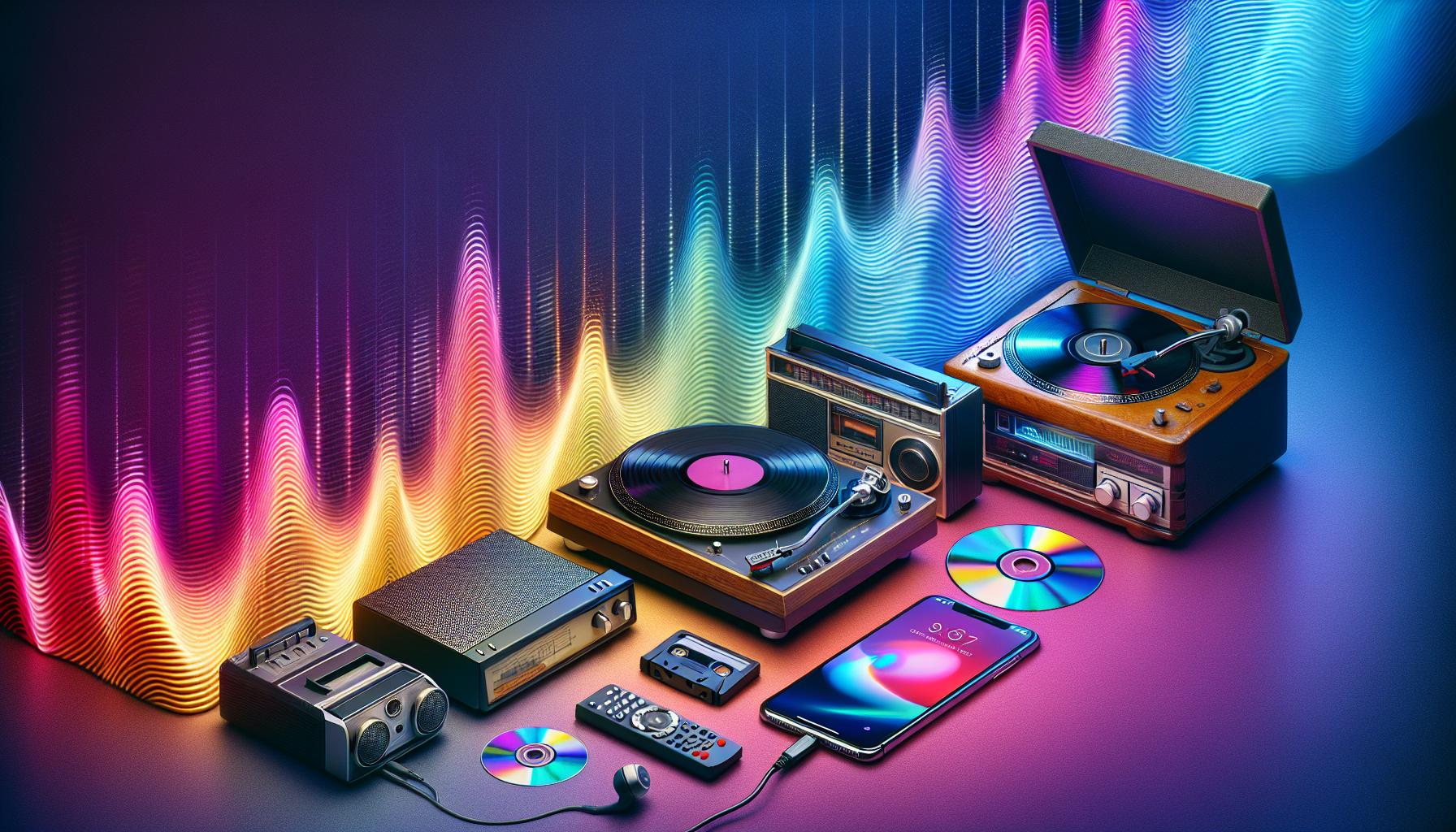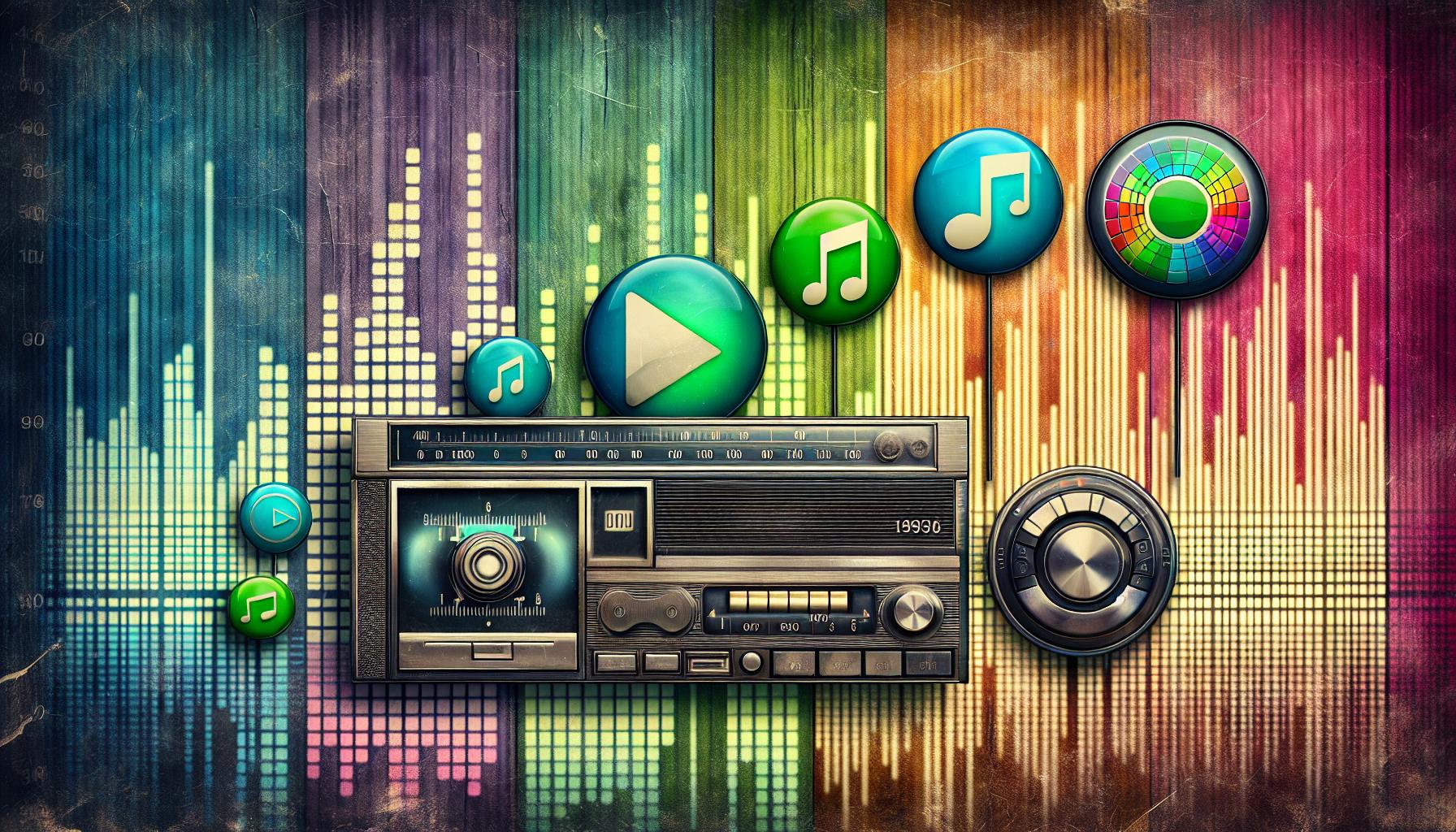The evolution of digital music has transformed how people create, share, and enjoy tunes. From the early days of digital sampling to the rise of streaming platforms, technology has reshaped the music landscape in ways that were once unimaginable. This journey not only reflects advancements in technology but also highlights shifts in cultural consumption and artistic expression.
As digital formats gained popularity, musicians and listeners alike embraced new possibilities. The transition from vinyl and cassettes to MP3s and streaming services marked a significant turning point, making music more accessible than ever. Understanding this digital music history reveals the intricate relationship between innovation and creativity, paving the way for the vibrant music scene we experience today.
Key Takeaways
- Evolution of Digital Music: Digital music history showcases a significant shift from analog formats to digital, fueled by technological advancements such as CDs, MP3s, and streaming services.
- Impact of MP3 and Streaming: The MP3 format revolutionized music sharing and storage, while streaming services like Spotify and Apple Music changed consumer habits from ownership to access.
- Changing Distribution Models: The rise of legal digital sales platforms, such as iTunes, and streaming services enhanced artist reach and revenue, resulting in a decline of traditional physical sales.
- Consumer Behavior Shifts: Modern audiences prefer personalized music experiences, leveraging playlists and algorithms to discover new content, contrasting previous trends of full-album purchases.
- Role of Social Media and Mobile Devices: Social media platforms play a crucial role in music discovery and promotion, while mobile devices ensure music accessibility anytime and anywhere, reshaping listening habits.
- Future Trends and Technology: Advancements like AI, blockchain, and immersive audio experiences are poised to redefine music creation and consumption, fostering innovation and fair compensation for artists.
Digital Music History
Digital music history encompasses the transformative journey from analog audio formats to digital solutions. Starting in the late 20th century, the introduction of the compact disc (CD) in 1982 marked a notable milestone. CDs offered improved audio fidelity compared to vinyl records and cassettes, setting the stage for digital music’s rise.
In the 1990s, the development of audio compression technologies led to the creation of the MP3 format. MP3s drastically reduced file sizes without significant loss in audio quality. This innovation facilitated easier music sharing, particularly through emerging peer-to-peer platforms like Napster, which significantly disrupted traditional music distribution models.
The early 2000s witnessed the growth of legal digital music sales, with platforms such as iTunes launching in 2003. iTunes provided a straightforward purchasing experience, allowing consumers to buy individual tracks rather than full albums. This model contributed to the decline of physical sales, prompting record labels to adapt their strategies to the new digital landscape.
Streaming services further revolutionized music consumption beginning in the late 2000s. Platforms like Spotify and Apple Music introduced subscription models that gave users access to vast libraries of music for a monthly fee. This shift changed how listeners discovered and interacted with music, favoring instant gratification over long-term ownership.
The evolution of digital music is marked by continuous advancements in both technology and distribution methods. It highlights the ongoing relationship between artists, audiences, and the platforms that mediate their interactions. As technology progresses, digital music continues to influence how artists create and share their work while enhancing accessibility for global audiences.
Early Developments

Digital music began transforming the music landscape in the late 20th century, driven by technological advances that allowed for new ways to create and share audio. These developments laid the foundation for the digital music revolution.
The Birth Of Digital Audio
Digital audio’s origin traces back to the 1960s when researchers developed pulse code modulation (PCM), enabling sound waves to convert into digital data. In 1980, Sony and Philips launched the compact disc (CD), a significant advancement that offered a compact storage solution and improved audio quality over analog formats. The CD’s launch marked the beginning of digital audio’s mainstream acceptance, setting the stage for further innovations in music consumption.
Key Innovations In Technology
Several key innovations shaped digital music’s evolution:
- Audio Compression: The introduction of audio compression formats like MP3 in the 1990s significantly reduced file sizes without substantial loss of quality, facilitating music sharing online.
- Peer-to-Peer Sharing: Platforms like Napster emerged in the late 1990s, enabling users to exchange music files directly, which disrupted traditional music distribution methods.
- Legal Digital Sales: The launch of iTunes in 2001 marked a turning point for legal digital music sales, allowing consumers to purchase and download individual tracks seamlessly.
- Streaming Technology: The late 2000s introduced streaming services such as Spotify, which utilized advanced algorithms for personalized recommendations, allowing instant access to vast music libraries.
These innovations collectively transformed how music was created, distributed, and consumed, paving the way for future developments in digital music.
The Rise Of Digital Music Formats

The advent of digital music formats drastically changed the music industry and consumer habits. Key innovations, such as the MP3 format and streaming services, played significant roles in this transformation.
MP3 Revolution
The MP3 format, developed in the early 1990s, revolutionized digital audio. It utilized audio compression algorithms to reduce file sizes without significantly sacrificing quality. This compression facilitated music sharing and downloading, leading to the rise of peer-to-peer networks like Napster in 1999. Data showed that Napster attracted over 10 million users within a year, reshaping music distribution. Legal challenges followed, but MP3’s popularity spurred further developments in music players and software, with Apple’s iPod launch in 2001 showcasing its potential. By 2003, the iTunes Store emerged, allowing consumers to store and purchase music digitally, establishing a new standard for music consumption.
Streaming Services Emergence
The late 2000s marked the emergence of streaming services, which transformed how people accessed music. Platforms like Pandora and Spotify introduced subscription models in the early 2010s, offering users unlimited access to vast music libraries. Subscriptions surged; Spotify reported 345 million users in 2021, with 155 million subscribing to its paid service. This shift emphasized convenient, on-demand access over ownership of music. Additionally, streaming provided artists with new revenue streams through royalties, creating a more diverse musical landscape. The success of these services highlighted changing consumer preferences and set a precedent for future music distribution models.
Impact On The Music Industry

Digital music transformed the music industry fundamentally, influencing distribution models and consumer behaviors significantly.
Changes In Distribution Models
Digital music introduced innovative distribution models that reshaped how artists share their work. The transition from physical formats to digital formats allowed for rapid dissemination of music. Platforms like iTunes established legal digital sales, enabling consumers to purchase individual songs or albums online. This model reduced reliance on physical stores and broadened artists’ reach, allowing them to sell directly to global audiences. Streaming services, such as Spotify and Apple Music, further revolutionized distribution by offering extensive libraries on subscription bases. These services prioritized instant access over ownership, changing industry dynamics and encouraging new revenue models through royalties.
Shifts In Consumer Behavior
Digital music influenced consumer behavior by shifting preferences from ownership to access. Consumers began favoring streaming services, valuing the ability to listen to vast libraries without the limitations of physical collections. They transitioned from purchasing albums to compiling personal playlists, leading to a more personalized listening experience. Flexible pricing options, including ad-supported free tiers, made music more accessible to a broader audience. This shift also encouraged discovery, with algorithms suggesting new artists and genres based on listening habits, further diversifying musical tastes. As a result, the music industry adapted to meet evolving consumer expectations, emphasizing ease of access and personalized content.
Cultural Shifts In Music Consumption
The transformation of music consumption has been profoundly impacted by digital technologies and changing societal norms. Cultural shifts reflect evolving preferences for accessibility and the means through which audiences engage with music.
The Role Of Social Media
Social media platforms have significantly changed how consumers discover and interact with music. Artists leverage platforms like Instagram, TikTok, and Twitter to promote their work, connect with fans, and foster community engagement. Viral trends often propel songs to mainstream success, demonstrating the power of user-generated content in shaping listening habits. A notable example is the rise of TikTok, where short videos featuring snippets of songs can lead to widespread popularity, driving millions of streams on platforms like Spotify. This immediate access to music through social channels emphasizes cultural engagement over traditional marketing strategies.
The Influence Of Mobile Devices
Mobile devices play a critical role in reshaping music consumption habits. With increased smartphone adoption, music is now accessible anytime, anywhere. Streaming applications designed for mobile platforms provide users with on-demand listening capabilities, allowing for personalized playlists and tailored recommendations. Approximately 80% of users stream music via mobile devices, illustrating a strong preference for convenience in music consumption. This shift supports multitasking behaviors, where users engage with music while commuting, exercising, or working. As mobile technology continues to advance, it will further influence how audiences connect with music.
Future Trends In Digital Music
Digital music continues to evolve, influenced by technological advancements and changing consumer behaviors. Several trends are shaping the future landscape of music consumption and production.
Advances In Technology
Advancements in audio technology, such as artificial intelligence (AI) and machine learning, impact music creation and curation. AI-driven tools assist musicians in composing, mixing, and mastering tracks quickly and efficiently. For instance, platforms like Amper Music and AIVA generate original music using AI, enabling creators to produce high-quality content without extensive technical skills.
Blockchain technology also emerges as a solution for fair artist compensation. By securely tracking music rights and royalties, this technology enhances transparency and reduces disputes over payments, benefiting independent artists. Companies like Audius utilize blockchain to empower creators and connect them directly with listeners, eliminating intermediaries.
Furthermore, immersive audio experiences, including spatial audio and virtual reality (VR), redefine how audiences experience music. Services like Apple Music provide spatial audio options that utilize Dolby Atmos technology, creating a more engaging listening experience that surrounds the listener.
Emerging Genres and Platforms
The rise of digital platforms fuels the emergence of new music genres and styles. Genres such as lo-fi hip-hop and bedroom pop gain traction through platforms like SoundCloud and Bandcamp, allowing independent artists to share their work with global audiences. These platforms facilitate genre blending and experimentation, leading to innovative sounds.
Additionally, social media platforms, notably TikTok, influence trends and popularize new genres. Viral challenges and trends enable songs to reach wide audiences quickly. As artists leverage these social media channels for promotion, significant shifts in genre popularity occur, with dance-pop and indie rock seeing resurgence due to viral content.
New platforms also emerge, focusing on unique music experiences. For example, platforms like Discord allow musicians to engage directly with fans through live-streamed performances and community interactions, fostering unique fan experiences.
Innovations in both technology and platform accessibility ensure that digital music remains dynamic and ever-evolving. The potential for artists to reach new audiences and explore diverse creative avenues appears promising as these trends unfold.
Landscape Of The Music Industry
Digital music has transformed the landscape of the music industry and how audiences engage with sound. The shift from physical formats to digital platforms has not only increased accessibility but also reshaped consumer behaviors and artist interactions. As technology continues to advance, the potential for innovation in music creation and distribution remains vast.
Emerging trends like AI-driven music production and blockchain technology promise to enhance artist compensation while fostering new genres and styles. The future of digital music holds exciting possibilities, ensuring that both artists and listeners will continue to experience a rich and evolving musical journey.